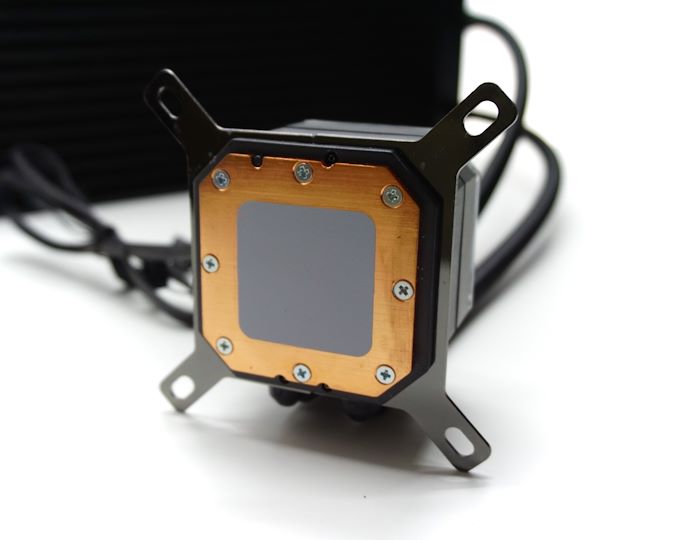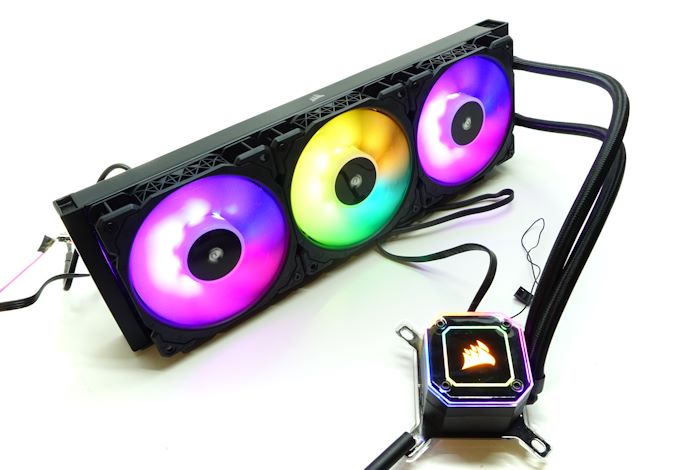The Corsair H150i Elite Capellix AIO Cooler Review: Go Big Or Go Home
by E. Fylladitakis on October 15, 2020 9:30 AM EST- Posted in
- Cases/Cooling/PSUs
- Corsair
- Water Cooling
- Liquid Cooling
- RGB
- iCUE
Conclusion
All-in-one CPU coolers first hit the market in force over a decade ago, which since then has allowed for more than enough time for developers to optimize their thermal performance, leaving little room for additional raw performance advancements. Nowadays, with many manufacturers retailing AIO cooler solutions, the market is pretty much saturated, a common outcome in the world of PC parts. Because of this, Corsair is always striving to maintain a competitive advantage by designing products with unique features, which is what made the release of the H150i Elite Capellix an anticipated move.
Where the H150i Elite Capellix has the lead over most of the competition is in terms of quality. Corsair ensured that their top AIO cooler is very well made, with excellent materials and a solid overall build quality. They also supply top-tier and fairly expensive MagLev cooling fans with the cooler, something that is often overlooked despite the fans being one of the most important parts of an AIO cooler.
The prime marketing feature of the H150i Elite Capellix is the included Commander CORE module and its compatibility with Corsair’s iCUE ecosystem. This opens up practically limitless user-programmable options, both aesthetic and practical. Except from the versatility that the iCUE software affords to the H150i Elite Capellix itself, it also enables greater control over other system fans and lights, allowing for system-wide lighting programming and sensory input. For example, it is easy to change the lighting of the cooler depending on which gaming profile is selected or for all compatible devices to share exactly the same lighting effect. The disadvantage of this feature is simple and obvious – this kind of total synergy only works with iCUE compatible devices, meaning that not even all of Corsair’s products are compatible with this feature.
However when it comes to performance, the H150i Elite Capellix barely any better than the H150i Pro RGB that the company released two years ago. We suspected as much from before we tested the cooler, as it is obvious that both coolers share the same radiator and tubing. The H150i Elite Capellix technically leads our thermal performance charts but the very powerful 2400 RPM fans are primarily responsible for this, which actually damage the cooler’s noise-to-performance ratio. Running the fans of the H150i Elite Capellix at the same speed as the fans of the H150i Pro RGB yields virtually the same performance, with but a tiny advantage for the H150i Elite Capellix – an advantage so small that can easily be a statistical error. Regardless, the quick fans provided with the H150i Elite Capellix offer greater versatility, as they can be programmed to stay quiet but also can be made loud if, for whatever reason, the user needs them to be.
Although the H150i Elite Capellix does not have a distinct performance advantage over the previous generation of cooler, its MSRP of $189 actually is reasonable and competitive. Despite the included Commander CORE, iCUE compatibility, and other minor upgrades, it's the same MSRP as the older H150i Pro RGB, making for a pleasant surprise as it means Corsair hasn't raised priced. In fact, it's generally priced close to – or even lower than – most of its direct competition. So from a performance standpoint, although Corsair hasn't managed to really move the needle on performance or pricing for their new cooler, the latest H150i is (still) just as competitive as the previous version.
Ultimately, this means that although we can't recommend the H150i Elite Capellix as an upgrade over a previous-generation cooler, Corsair continues to deliver a solid AIO cooler as far as new builds are concerned. The small quality of life improvements that come with newest H150i will help ensure that Corsair keep its advantage with unique features, all the while offering a better value to users that are considering a large AIO cooler today.













37 Comments
View All Comments
29a - Friday, October 16, 2020 - link
It has to do with the price of copper vs aluminum.Slash3 - Friday, October 16, 2020 - link
Alphacool and Be Quiet offer full copper block/rad AIOs.Quantumz0d - Thursday, October 15, 2020 - link
I think GN's test shows AiOs being somewhat superior. But as for the Air cooling vs AiO, I will always choose Air coolers. Noctua is top quality and the best part is you get a superb looking beast machine, vs the RGB vomit and cabling issues, and the most important aspect being the lifetime. AiOs always no matter what the coolant will be losing it's efficiency overtime also the particulates in the mixture. Any small leak in any time = death of the data + hard cash. No risks no half measures, only full measures = Air cooling.My build for a long term plan of a PC (usually they can last more than 10 years), will be Noctua Chromax black and red, with no RGB G.Skill B-Die, maybe the mobo / GPU gets a little lighting to make it look even intense of the coloring to match the Chromax.
StevoLincolnite - Thursday, October 15, 2020 - link
My current PC is 11 years old and uses a Corsair Hydro AIO water cooler.No issues.
TelstarTOS - Thursday, October 15, 2020 - link
The usual strategy, performance at price of high noise.Manch - Thursday, October 15, 2020 - link
Short of making the radiator bigger, would adding a reservoir help cooling at this point?Everett F Sargent - Thursday, October 15, 2020 - link
Yes, of course. As long as the reservoir is big enough. Ideally you want the coolant to return to its initial ambient temperature. The major problem with all liquid cooling solutions is an inherent inability to return the coolant back to its original ambient temperature. All you have to do is try to touch the radiator or use an IR digital thermometer.The equation is as simple as Q=VA (Q is the flow rate in liters per second) and the coolant volume or total amount of coolant in the loop, VC = liters, so that VC/Q = seconds or mean residence time, the bigger that number the better chance you have of returning the coolant to its original ambient temperature. The goal is to maintain the maximum delta temperature between the coolant and the CPU. Hot (to the touch or via IR thermometry) radiators defeat the entire exercise (or some fraction thereof) to begin with in the 1st place.
Tomatotech - Friday, October 16, 2020 - link
You are correct in that coolant volume is a factor, however heat flow rate from the radiator is also a large factor. For the same size radiator, factors affecting heat flow would be: thermal conductivity of the radiator, exposed surface area of the radiator, airflow across the radiator. If any of these are very high then cooling* will be effective even with tiny coolant volume.*Reduction of increase in temperature above internal working temperature of CPU. Over time, all radiator systems, even maximally efficient ones, will reach a temperature of at least the internal temperature of the CPU.
Everett F Sargent - Friday, October 16, 2020 - link
Yes there are many factors, but I think my basic claim still holds true. Keeping the coolant temperature low is a must, or preferred, all other things being equal. But I think I will do a little more on quantifying those calculations with my new build.Everett F Sargent - Thursday, October 15, 2020 - link
Go bigger or go home ...https://www.performance-pcs.com/water-cooling/aio-...
Currently out of stock as I got the last one.